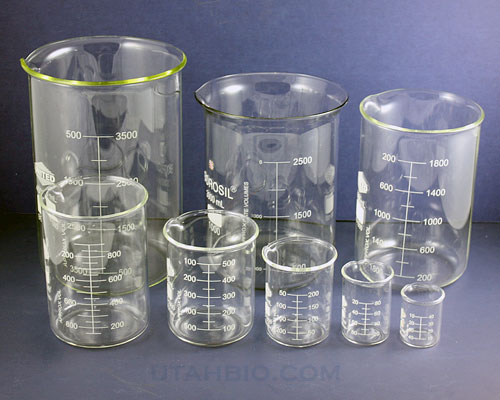Beakers vs. Erlenmeyer Flasks: Which is Better for Your Experiment?

In a laboratory setting, professionals use a variety of equipment options to measure, store, and transport liquids. Of those options, beakers and Erlenmeyer flasks are two of the most common and popular. The key difference between these two is their shape. The Erlenmeyer flask is known for its conical shape, while the beaker is cylindrical. That isn’t the only difference, however, they have different applications.
Beakers vs Erlenmeyer Flasks
There is an overlap between beakers and Erlenmeyer flasks, they do provide some of the same uses. However, they also perform specific tasks that the other option is unsuitable for.
Beakers
In addition to being cylindrical, a beaker has a flat bottom. Most beakers feature a beak to make pouring liquids safe and straightforward. They come in a wide range of sizes, from as small as a single millilitre up to many litres. It’s easy to identify beakers from Erlenmeyer flasks on sight because beakers have straight sides. While some suggest beakers are suitable for measurements, they only provide accuracy within 10%, which may be suitable for some uses, but dangerous for others.
Within the beaker category, there is a range of different products available. The most popular or common is the Griffin beaker, but tall and low-form options are also available.
Erlenmeyer Flasks
Like the beaker, the Erlenmeyer flask also has a flat bottom. It’s an important tool for use in quantitative chemical analysis. Due to its shape, it’s popular for boiling, mixing, filtration, storage and other processes that involve handling chemicals and other liquids.
Erlenmeyer flasks are commonly used in both chemistry and biology settings.
Key Differences
While Erlenmeyer flasks have lids, beakers don’t generally due to the presence of spouts. It is easier to lid the flask, but it is also easier to use a funnel for pouring liquids directly into it as well. The true differences between the two are in their uses.
A beaker is an ideal solution for decanting, mixing, and titration. An Erlenmeyer flask makes mixing and swirling without losing liquid easy due to its sloped walls and narrow neck. It’s also suitable for boiling liquids, recrystallisation, and preparing microbial cultures.
In addition to their differences, they do share some similarities. You may expect both items to be solely available in glass, however, they come in a variety of materials. Beakers are available in glass, plastic, stainless steel, and aluminum. Erlenmeyer flasks are available in a variety of hard plastics and different glass types as well.
Final Thoughts
While these two tools may look similar, they are very different indeed. Most laboratories will stock both, and the technicians will use the appropriate tool depending on their task.
Beakers are often used to transport chemicals from one area of the lab to another, using watch glass as a lid to prevent contamination. They are particularly popular for measuring because of their distinct markings, but you should take steps to test the accuracy of these measurements. Flasks are useful for measuring, heating, and holding chemicals. They are made of thickened durable glass which makes them safe for chemical use.





